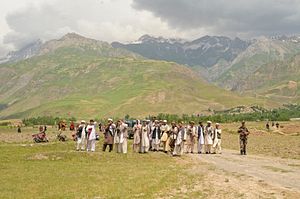In the span of a week, two high-level U.S. government figures paid visits to Tajikistan. On April 25, commander of U.S. Central Command, General Joseph Votel, made a visit to Dushanbe. Less than a week later, from April 30 to May 3, Deputy Assistant Secretary of State for Central Asia Daniel N. Rosenblum traveled to Dushanbe and Gharm.
Visits by the commander of CENTCOM to Tajikistan are a yearly occurrence. Votel made the trip last June, a few months after assuming the post. His predecessor, General Lloyd Austin, visited Tajikistan in August 2015, July 2014, and July 2013. General James Mattis, during his tenure leading CENTCOM, made the trip as well.
Rosenblum’s visit was not necessarily unusual either, though diplomats make the trip to Central Asia will less frequency than their military counterparts. In 2015, Rosenblum was in Tajikistan twice, laying the groundwork for the launch of the late-Kerry State Department’s C5+1 platform which was officially launched in November 2015. As Paul Stronski noted in a recent conference in Washington, Central Asia is not a priority on its own. Its position relative to Afghanistan brings it into military discussions more readily, but diplomatic efforts and an evaluation of regional policy is far down on any administration’s to-do list.
Recycled Central Asia policy or not, fighting in northern Afghanistan is keeping Tajikistan a relevant player. Fighting in Kunduz and Badakhshan provinces, both of which border Tajikistan, at first seemed to draw little response from Dushanbe. On May 2, Eurasianet reported on the brief seizure of Zebak district in Badakhshan — a fight that could, according to their local sources, be heard in the Tajik border town of Ishkashim. The fight “is eliciting no evident alarm in Dushanbe,” the report assessed. A handful of Afghan soldiers were reportedly being treated in the town’s clinic.
On May 5, Tajik President Emomali Rahmon spoke to Afghan President Ashraf Ghani.
By May 6, media reports indicated that Zebak had been retaken but fighting continued elsewhere in the region. Qala-e-Zal district in Kunduz has reportedly fallen to the Taliban, who are now setting their sights on Kunduz city again.
How concerned should Tajikistan — and by extension Central Asia — be about renewed fighting in the borderlands?
The Taliban recently reiterated its goals in a “clarification statement regarding Operation Mansouri.” (Operation Mansouri is what the Taliban has titled its Spring Offensive, launched Friday). According to the Taliban, they have “conquered vast areas including some straddling on the country’s borders” in the opening moves of Operation Mansouri. “Therefore we consider it opportune to once again reassure our neighbors that the aim of our struggle is to liberate our land from foreign occupiers,” the statement says. “We have no intention of meddling in others’ affairs and nor will we allow others to interfere in our internal affairs.”
According to VOA, however, Afghan officials say there are Central Asians among the Taliban and Russians have been providing weapons to the insurgents. The first claim is somewhat misleading. Given that Tajiks are estimated to be the second-largest ethnic group in Afghanistan, following Pashtuns, and Uzbeks the fourth-largest, their presence in northern Afghanistan is nothing unique. Rivalries between Tajik, Uzbek, and Pashtun-led mujahideen groups was a feature of Afghanistan’s 1990s-era civil war. Given that the states of Central Asia have only been independent for 25 years and the Tajiks and Uzbeks of Afghanistan have lived in Afghanistan for generations, calling them “Central Asians” is wordplay.
So should Tajikistan be worried? Perhaps, but only as far as one country ought to be disturbed by violence on its borders. The Taliban have not, to date, made anything other than tactical movements along Afghanistan’s Central Asian border; they have not set their sights on conquering the region and there’s little evidence of their movement inspiring large groups of Central Asians to similar insurgencies.

































